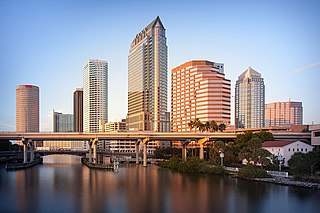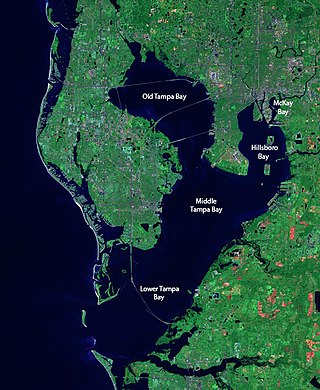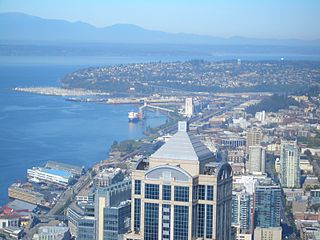
Pinellas County is a county located on the west central coast of the U.S. state of Florida. As of the 2020 census, the population was 959,107, which makes it the seventh-most populous county in the state. It is also the most densely populated county in Florida, with 3,491 residents per square mile. The county is part of the Tampa–St. Petersburg–Clearwater, Florida Metropolitan Statistical Area. Clearwater is the county seat. St. Petersburg is the largest city in the county, as well as the largest city in Florida that is not a county seat.

Tampa is a city on the Gulf Coast of the U.S. state of Florida. The city's borders include the north shore of Tampa Bay and the east shore of Old Tampa Bay. Tampa is the largest city in the Tampa Bay area and the seat of Hillsborough County. With an estimated population of 398,173 in 2022, Tampa is the 49th most populous city in the country and the 3rd most populous city in Florida after Jacksonville and Miami.

The Rough Riders was a nickname given to the 1st United States Volunteer Cavalry, one of three such regiments raised in 1898 for the Spanish–American War and the only one to see combat. The United States Army was small, understaffed, and disorganized in comparison to its status during the American Civil War roughly thirty years prior. Following the sinking of USS Maine, President William McKinley needed to muster a strong ground force swiftly, which he did by calling for 125,000 volunteers to assist in the war. The U.S. had gone to war in opposition to Spanish colonial policies in Cuba, which was then torn by a rebellion. The regiment was also nicknamed "Wood's Weary Walkers" for its first commander, Colonel Leonard Wood. This reflected their dissatisfaction that despite being cavalry, they ended up fighting in Cuba as infantry, since their horses were not sent there with them.

Tampa Bay is a large natural harbor and shallow estuary connected to the Gulf of Mexico on the west-central coast of Florida, comprising Hillsborough Bay, McKay Bay, Old Tampa Bay, Middle Tampa Bay, and Lower Tampa Bay. The largest freshwater inflow into the bay is the Hillsborough River, which flows into Hillsborough Bay in downtown Tampa. Many other smaller rivers and streams also flow into Tampa Bay, resulting in a large watershed area.

Ybor City is a historic neighborhood just northeast of downtown Tampa, Florida, United States. It was founded in the 1880s by Vicente Martinez-Ybor and other cigar manufacturers and populated by thousands of immigrants, mainly from Cuba, Spain, and Italy. For the next 50 years, workers in Ybor City's cigar factories rolled hundreds of millions of cigars annually.

Interbay is a neighborhood in Seattle, Washington consisting of the valley between Queen Anne Hill on the east and Magnolia on the west, plus filled-in areas of Smith Cove and Salmon Bay. The neighborhood is bounded on the north by Salmon Bay, part of the Lake Washington Ship Canal, across which is Ballard; on the south by what remains of Smith Cove, an inlet of Elliott Bay; on the east by 15th Avenue W. and Elliott Avenue W.; and on the west by the BNSF Railway. The Ballard Bridge crosses the ship canal from Interbay to Ballard.

Henry Bradley Plant, was a businessman, entrepreneur, and investor involved with many transportation interests and projects, mostly railroads, in the southeastern United States. He was founder of the Plant System of railroads and steamboats.

Magnolia is the second largest neighborhood of Seattle, Washington by area. It occupies a hilly peninsula northwest of downtown. Magnolia has been a part of the city since 1891. A good portion of the peninsula is taken up by Discovery Park, formerly the U.S. Army's Fort Lawton.

Lee Hall is an unincorporated town located in the extreme western portion of the independent city of Newport News in the Commonwealth of Virginia in the United States.

West Tampa is one of the oldest neighborhoods within the city limits of Tampa, Florida, United States. It was an independently incorporated city from 1895 until 1925, when it was annexed by Tampa.
The modern history of Tampa, Florida, can be traced to the founding of Fort Brooke at the mouth of the Hillsborough River in today's downtown in 1824, soon after the United States had taken possession of Florida from Spain. The outpost brought a small population of civilians to the area, and the town of Tampa was first incorporated in 1855.

The Henry B. Plant Museum is located in the south wing of Plant Hall on the University of Tampa's campus, located at 401 West Kennedy Boulevard in Tampa, Florida. Plant Hall was originally built by Henry B. Plant as the Tampa Bay Hotel; a 511-room resort-style hotel that opened on February 5, 1891, near the terminus of the Plant System rail line, also forged and owned by Plant. The Plant Museum's exhibits focus on historical Gilded Age tourism in the Tampa Bay area of Florida, the elite lifestyle of the hotel's guests, and the Tampa Bay Hotel's use during the Spanish–American War. As such, the Plant Museum is set up in the Historic House Museum style. Exhibits display artifacts in a manner that reflects the original placement and usage within the related historic building.

The Centro Asturiano is a historic site in Ybor City, Tampa, Florida. It is located at 1913 Nebraska Avenue. On July 24, 1974, it was added to the U.S. National Register of Historic Places. It was designed by Tampa architect M. Leo Elliott.

Downtown Tampa is the central business district of Tampa, Florida, United States, and the chief financial district of the Tampa Bay Area.

Ybor City is a historic neighborhood that includes the Ybor City Historic District in Tampa, Florida. It is located just northeast of downtown Tampa and north of Port Tampa Bay. The neighborhood has distinct architectural, culinary, cultural, and historical legacy that reflects its multi-ethnic composition. It was unique in the American South as a prosperous manufacturing community built and populated almost entirely by immigrants.

The cityscape of Tampa includes historic and architecturally noteworthy structures in its downtown and residential areas. The Seminole Heights and Hyde Park neighborhoods are two of the largest historic preservation districts in Tampa.

South Tampa is a region in the city of Tampa that includes the neighborhoods of Beach Park, Ballast Point, Bayshore Beautiful, Bayshore Gardens, Bayside West, Belmar Shore, Davis Islands, Port Tampa, Fair Oaks-Manhattan Manor, Golfview, Hyde Park, New Suburb Beautiful, Virginia Park, Palma Ceia, Rattlesnake Gandy-Sun Bay South, South Westshore, parts of Sunset Park and Courier City-Oscawana. MacDill Air Force Base is also included. The region represents District 4 of the Tampa City Council. The ZIP Codes serving the area are 33606, 33608, 33609, 33611, 33616, 33621, and 33629

The Florida Brewing Company building is a historic brewery building that once housed Ybor City Brewing Company, which became Florida Brewing Company. It has been restored and converted into a law office. It is the tallest building in Tampa's Ybor City Historic District.

The Port Tampa City Library is a library located in a historic bank building in the Port Tampa section of Tampa, Florida, at 4902 W. Commerce Street. It is a neighborhood branch in the Tampa-Hillsborough County Public Library System.



















